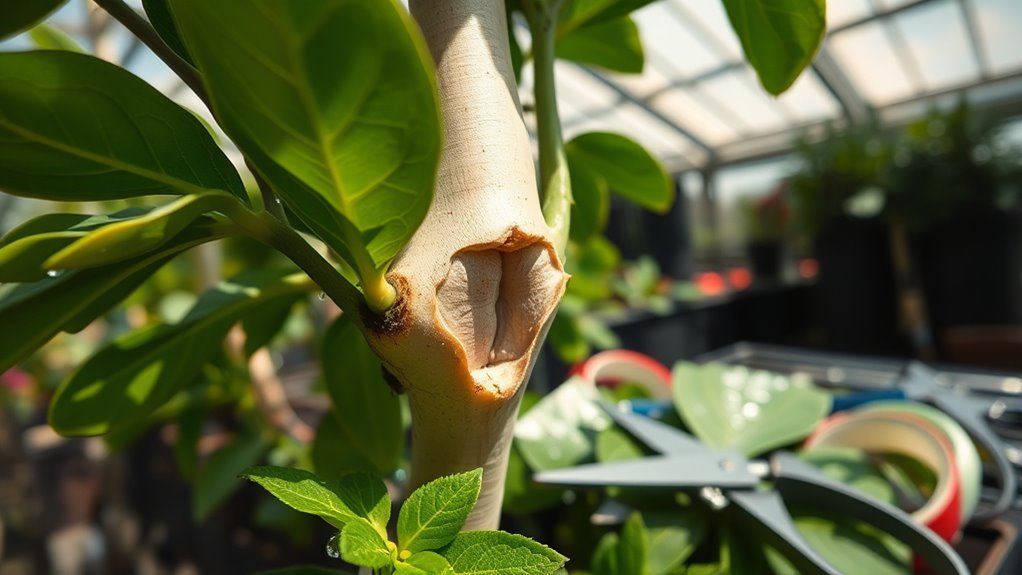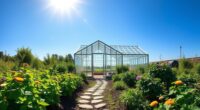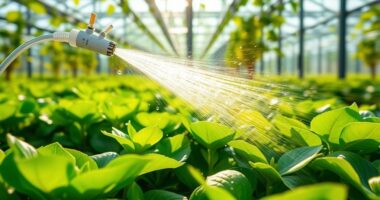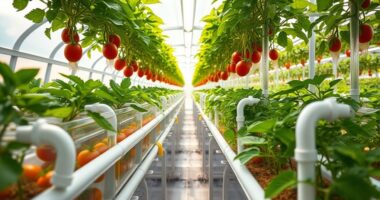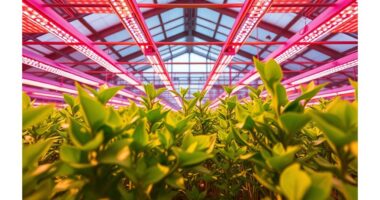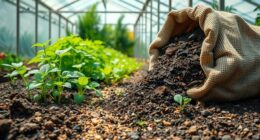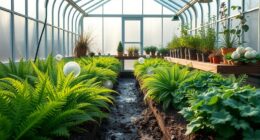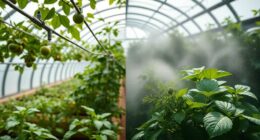Grafting techniques are key to boosting the health and productivity of your greenhouse plants. You can use methods like cleft grafting for larger rootstocks or whip and tongue grafting for younger trees. Tools like grafting knives, clips, and wax help make the process easier. To ensure success, maintain optimal temperature and humidity levels during healing. Each technique has its unique benefits, and there’s plenty more to discover about maximizing your grafting efforts.
Key Takeaways
- Cleft grafting is effective for larger rootstocks and rejuvenating old trees, enhancing health and productivity in greenhouse plants.
- Whip and tongue grafting is ideal for young trees with similar diameters, promoting successful integration.
- Budding is a highly efficient technique involving the insertion of a single bud into the rootstock.
- Inlay grafting utilizes a V-shaped notch to secure the scion, while four-flap grafting involves making four vertical cuts for better alignment.
- Proper healing conditions, including high humidity and optimal temperature, are crucial for successful grafting outcomes.
Purpose of Grafting in Greenhouse Plants
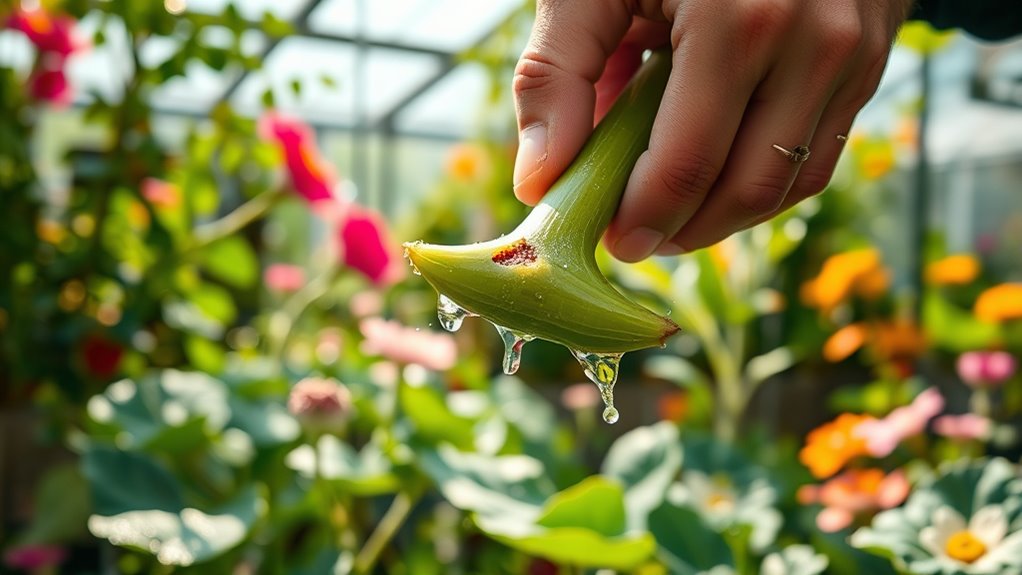
Grafting serves as a powerful tool for enhancing the health and productivity of greenhouse plants. By using rootstocks resistant to soil-borne diseases, you can significantly reduce infection risks.
Additionally, grafting combines scions with stress-tolerant rootstocks, helping your plants withstand environmental challenges like heat and salinity. This method also boosts growth vigor, improving nutrient and water uptake, which translates to better fruit production.
Moreover, grafting enhances overall yield by integrating desirable traits from different plants, making your crops more adaptable to varying conditions. Ultimately, these benefits lead to improved fruit quality and potentially longer plant lifespans, reducing the need for chemical interventions and maximizing your greenhouse’s economic advantages.
Common Grafting Techniques
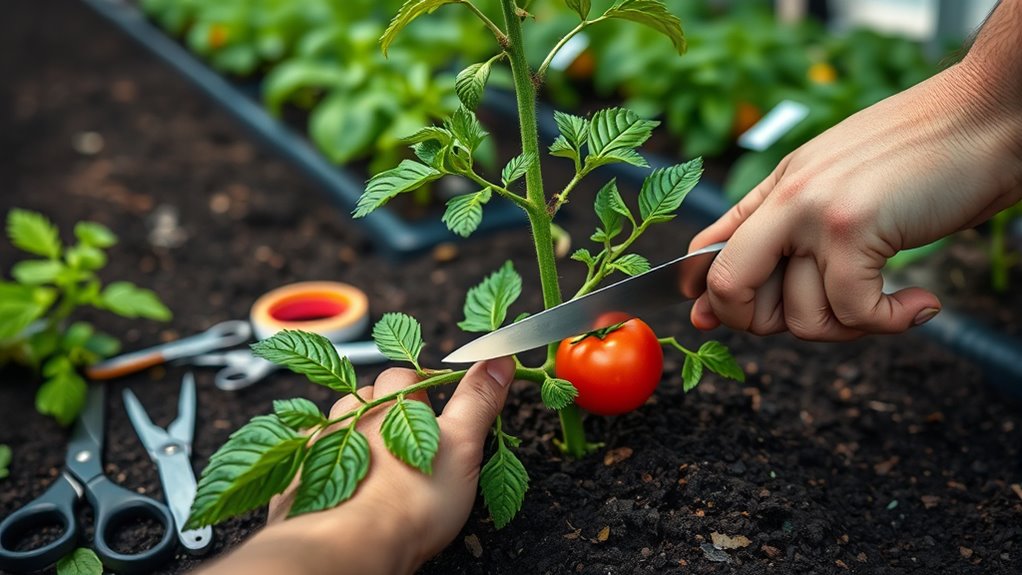
When it comes to enhancing greenhouse plants, several common grafting techniques stand out for their effectiveness and versatility.
Cleft grafting works well for larger rootstocks, perfect for rejuvenating old trees. If you’re working with young trees of similar diameters, whip and tongue grafting is your go-to option.
Cleft grafting rejuvenates older trees, while whip and tongue grafting is ideal for young trees of similar sizes.
Budding involves inserting a single bud into the rootstock, making it efficient for propagating desirable traits. For a unique approach, consider inlay grafting, which uses a V-shaped notch to secure the scion.
Lastly, four-flap grafting features four vertical cuts on both the scion and rootstock. Each technique has its specific applications, so choose the one that best suits the plant type and your goals in the greenhouse.
Essential Grafting Tools
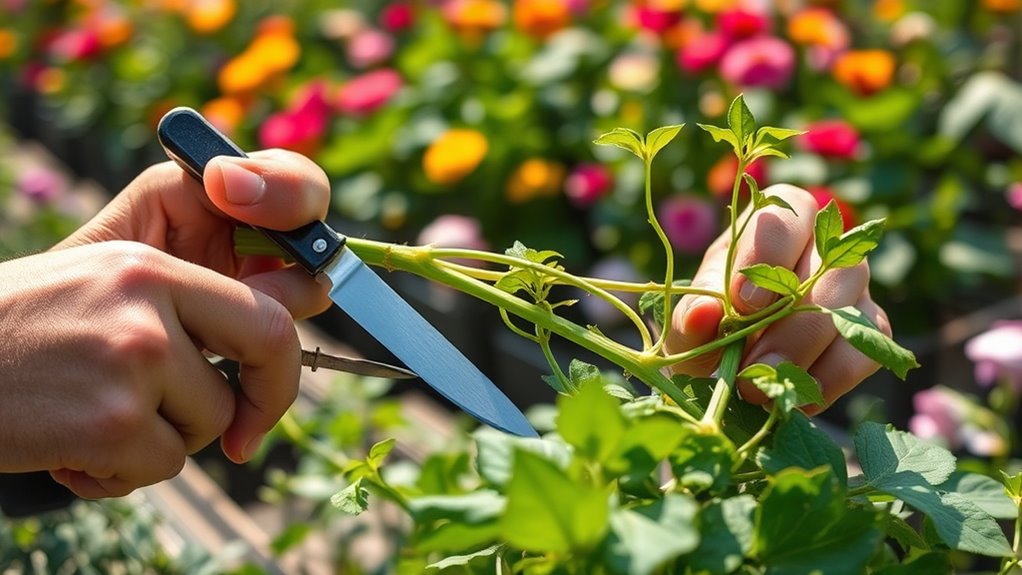
Successful grafting requires the right tools to ensure precision and promote healing.
You’ll want to start with a high-quality grafting knife, which allows for miter-cutting that enhances your speed and accuracy. Various grafting blades, like omega, V, and T cuts, cater to different techniques.
Grafting clips are essential for supporting newly grafted stems, while grafting tape—like Parafilm or white PVC—secures grafts effectively.
Don’t forget grafting wax, which seals wounds and blocks out air and moisture. For added support, rubber grafting strips and support stakes help your plants heal properly.
Grafting kits can simplify your setup, providing all necessary tools in one convenient package. Equip yourself well, and watch your grafting efforts thrive!
Optimal Healing Conditions
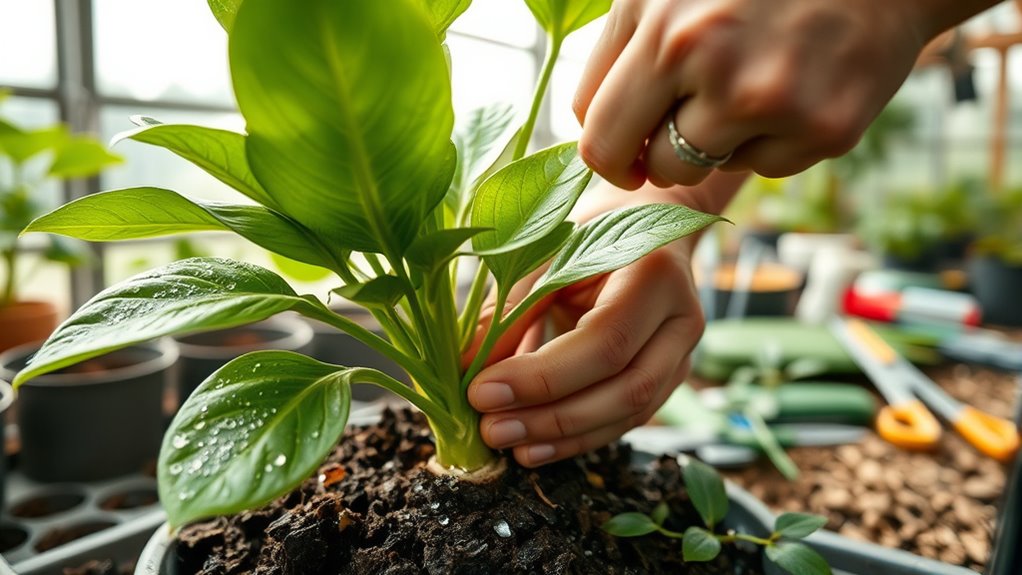
Creating the right environment for your grafted plants is crucial for optimal healing. Aim for a temperature range of 80°F to 85°F (27°C to 29°C) to promote successful graft integration.
Using propagation heat mats can help maintain consistent substrate temperatures, enhancing graft survival. High humidity levels of at least 95% are vital immediately after grafting, so consider using misting or sealed chambers. Gradually reduce humidity over the following days to prevent unwanted root formation.
For light conditions, provide near darkness for the first 2 to 4 days, then slowly increase exposure. Setting up a healing chamber with PVC pipes and plastic can help regulate these factors, ensuring your grafted plants thrive as they heal.
Grafting Process for Tomatoes
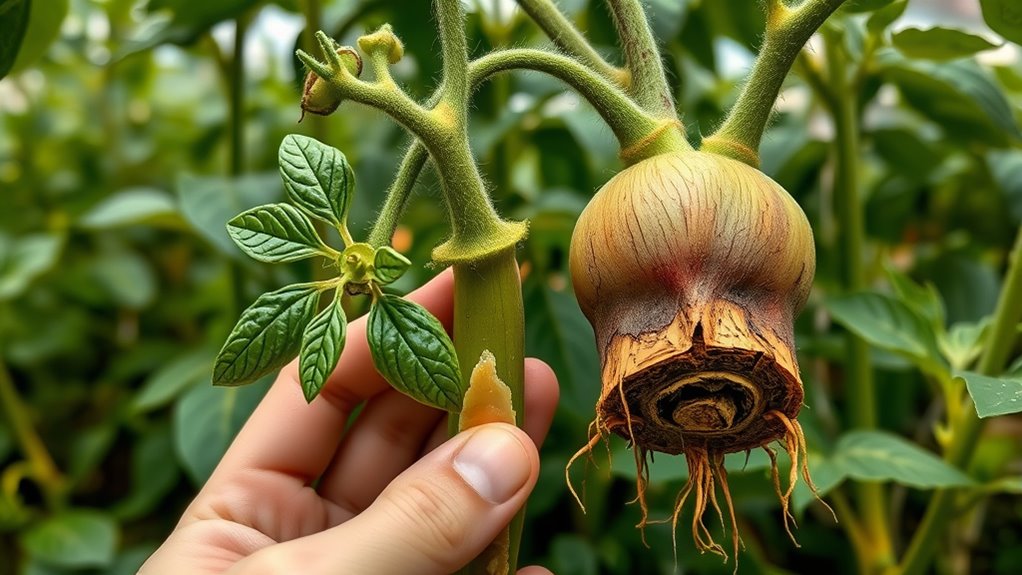
After setting up the ideal healing conditions, you can begin the grafting process for tomatoes.
Start by ensuring both your scion and rootstock seedlings are around 2 mm in diameter for a successful union. Use a sharp razor blade or grafting knife to make a clean 45- to 60-degree cut on your rootstock.
Next, position a grafting clip to hold the pieces together. Then, cut the scion at the same angle and insert it into the clip, making sure the two stems align well.
Position a grafting clip to securely hold the pieces together, ensuring the stems align perfectly for a strong union.
Remember, cleanliness is crucial to prevent contamination.
With practice, you’ll master this splice grafting technique, unlocking the benefits of disease resistance and improved yield for your tomato plants.
Grafting Applications Beyond Tomatoes
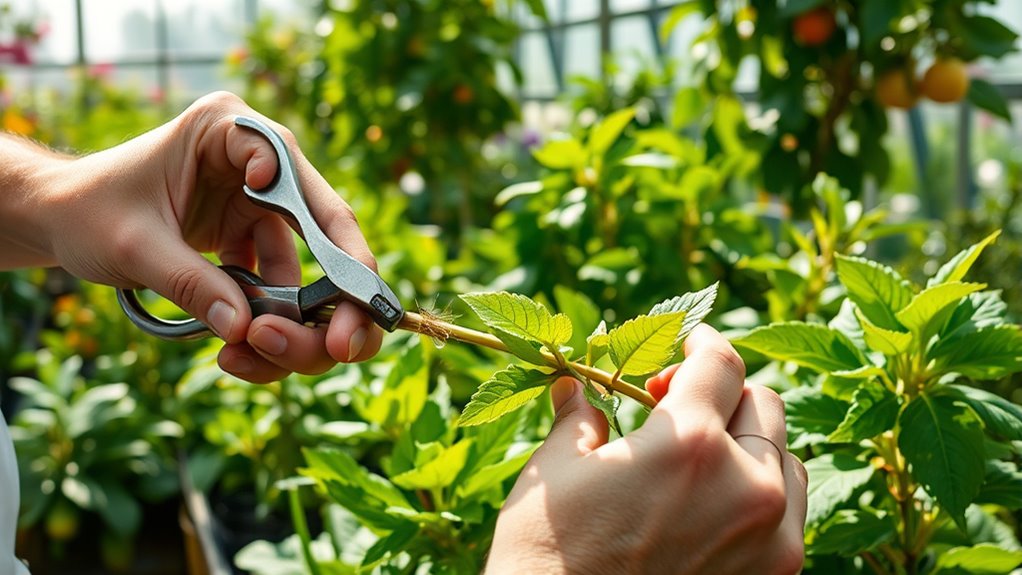
Grafting isn’t just for tomatoes; it’s a versatile technique that can significantly benefit a variety of greenhouse plants.
For instance, grafting eggplants onto resistant rootstocks not only enhances disease resistance but also boosts vigor and yields in tough environments.
You’ll find that cucumbers and melons benefit from grafting as well, improving their resistance to fusarium wilt and increasing economic viability.
Peppers also thrive when grafted, showing greater tolerance to stresses like drought.
Even squash, pumpkins, and some herbs can gain from grafting, improving their growth and disease resilience.
As you explore grafting beyond tomatoes, you’ll discover a world of possibilities that can elevate your greenhouse production.
Challenges in Grafting
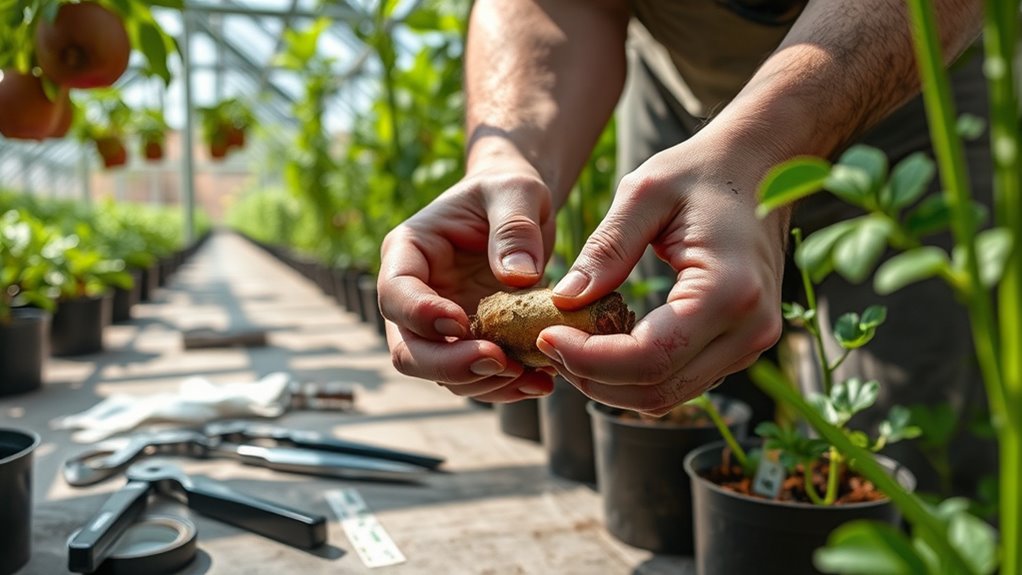
While exploring the benefits of grafting for various greenhouse plants, it’s important to recognize the challenges that come with this technique.
First, grafting can be costly due to rootstock prices and specialized equipment. You might also face high graft failure rates from poor techniques or environmental stress.
Maintaining strict sanitation is crucial to prevent contamination, which can complicate your efforts. Additionally, you need a high level of technical skill, posing a barrier for newcomers.
Limited automation means grafting remains a manual process, increasing labor costs. Finally, managing plant vigor and disease resistance requires ongoing attention to detail to ensure long-term success.
Addressing these challenges is key to mastering grafting in your greenhouse.
Importance of Scion-Rootstock Compatibility
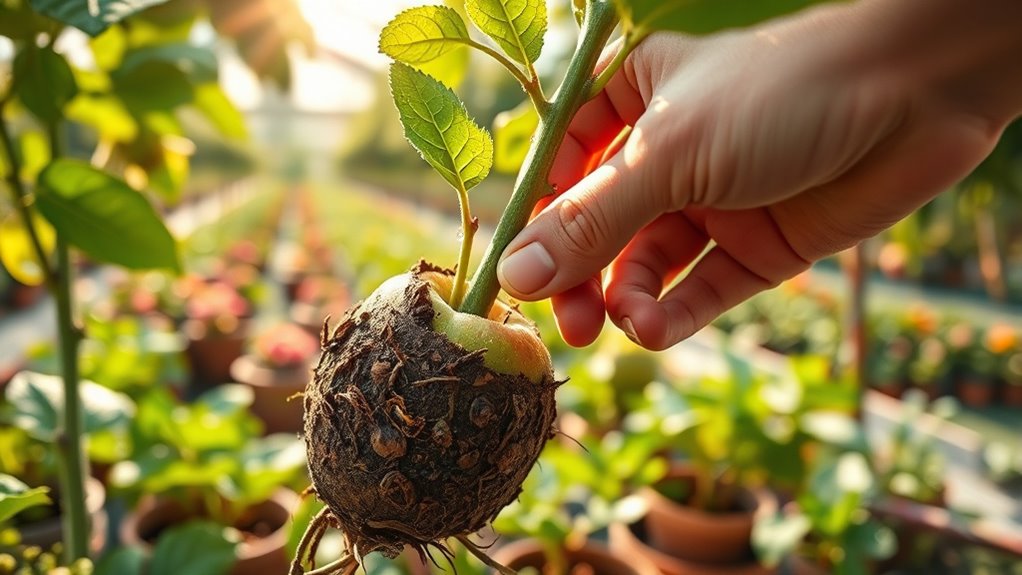
Understanding the importance of scion-rootstock compatibility is crucial for achieving successful grafting outcomes in your greenhouse. When the genetic proximity between your scion and rootstock is close, you typically see better graft unions and healthier plant growth.
Distantly related plants often suffer from incompatibility, leading to stunted growth or even plant death. Physiological and anatomical alignment, especially in the vascular cambium, is essential for a successful union.
A compatible combination not only enhances productivity but also improves stress tolerance and disease resistance. Remember, the right rootstock can influence not just growth but also fruit quality and yield.
Post-Graft Care and Monitoring
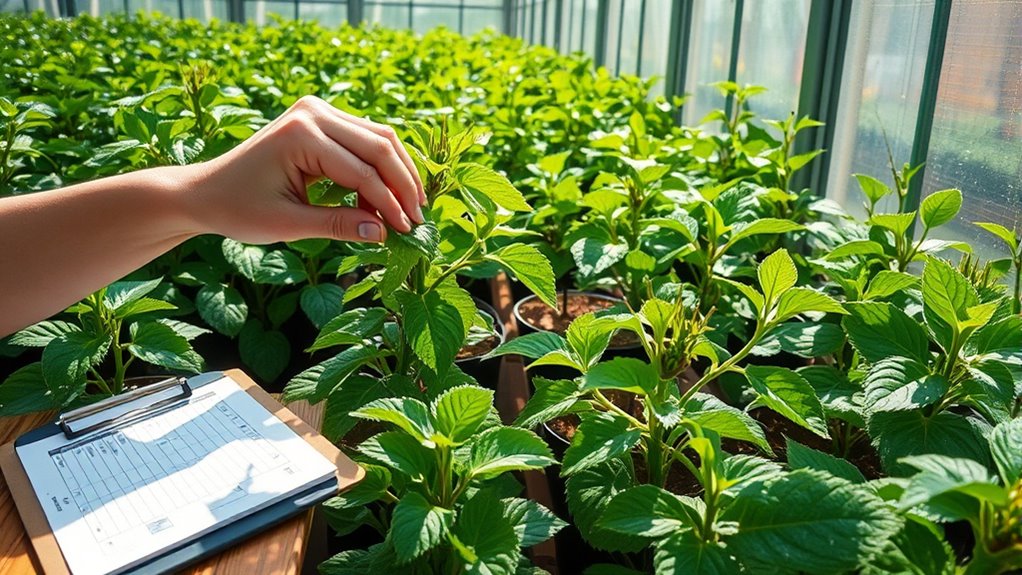
After ensuring scion-rootstock compatibility, your focus shifts to post-graft care and monitoring to support successful healing.
Start by maintaining high humidity levels around 95% for the first few days. Keep temperatures stable between 72°F and 85°F, ideally around 80°F.
Initially, limit light exposure to darkness for 1-2 days, then gradually increase to 500-700 fc. Set up a healing chamber using PVC frames, clear plastic, and shade cloth, ensuring it’s tightly sealed to retain moisture.
Regularly inspect the graft union for signs of healing or stress, adjusting humidity and temperature as needed. Gradually acclimatize the plants over 3-4 days, watching for wilting or other issues to ensure a smooth transition back to the greenhouse.
Frequently Asked Questions
What Types of Plants Can Benefit From Grafting?
You’ll find that various plants can benefit from grafting.
Fruit trees like apples and cherries thrive with increased disease resistance and size control.
Vegetables such as tomatoes gain vigor and resistance to soil-borne diseases.
Flowering plants, including roses, can develop better root systems.
Additionally, ornamental plants like rhododendrons are often grafted for compact forms.
How Long Does the Graft Healing Process Typically Take?
Think of graft healing like a friendship blossoming—it’s a process that takes time.
Typically, you’ll find that graft healing lasts between 7 to 14 days. In those crucial first days, the connection between the scion and rootstock strengthens.
Top grafts usually heal quicker, around 4 to 5 days, while side grafts may take a bit longer, about 6 to 7 days.
Patience is key as you nurture this new bond.
Can Grafting Be Done Year-Round in Greenhouses?
Yes, you can graft year-round in greenhouses!
The controlled environment, including temperature and humidity, allows you to perform grafting at any time, unlike outdoor conditions that are limited to dormant seasons.
Just make sure your plants are well-prepared and healthy before you start.
What Are Signs of a Successful Graft?
If you want to feel like a gardening superhero, look for signs of a successful graft!
You’ll notice new growth, like swelling buds or expanding leaves. A healthy scion should stay vibrant and green, while forming new vascular connections with the rootstock is crucial.
Keep an eye out for any decay at the graft union—absence of this is a great sign. Typically, you’ll see these indicators within 2 to 4 weeks after grafting!
How Do I Choose the Right Rootstock for My Scion?
To choose the right rootstock for your scion, consider its vigor and compatibility.
Look for rootstocks that resist diseases and adapt well to your soil and climate conditions.
Think about the growth habit you want, whether it’s dwarfing or standard size.
Also, ensure it’s easy to graft and fits your commercial needs if applicable.
Finally, test different rootstocks with your specific scion to evaluate performance and success rates.
Conclusion
In conclusion, grafting techniques can significantly enhance the health and yield of your greenhouse plants. Did you know that grafted tomatoes can yield up to 30% more fruit compared to non-grafted varieties? By mastering these techniques and ensuring scion-rootstock compatibility, you’ll set your plants up for success. Remember to monitor their progress and provide optimal conditions post-grafting. With a little practice, you’ll see the benefits in both growth and productivity. Happy grafting!
